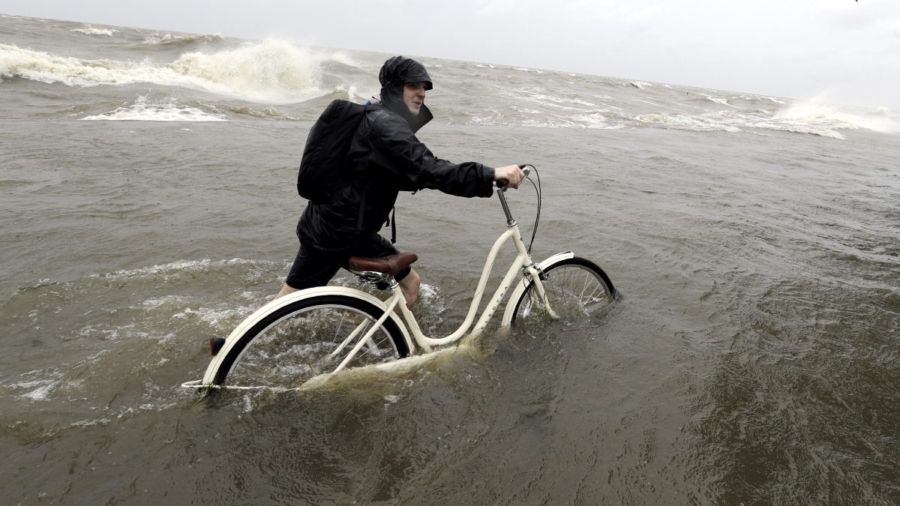NEW ORLEANS—Weakened but still potent, Barry inundated the Gulf Coast as it continued its slow advance on the morning of July 14, bringing fresh fears of flash flooding to Mississippi’s capital city even as it appeared unlikely to deluge New Orleans.
In Mississippi, up to 3 inches of rain had already fallen in the Jackson area before dawn Sunday—and more was on the way. That prompted the National Weather Service to issue a flash flood warning for the city and some of its suburbs.
President Donald Trump asked people across the region to keep their guard up, saying on Twitter: “A big risk of major flooding in large parts of Louisiana and all across the Gulf Coast. Please be very careful!”
A big risk of major flooding in large parts of Louisiana and all across the Gulf Coast. Please be very careful!
— Donald J. Trump (@realDonaldTrump) July 14, 2019
Forecasters warned of a continued threat of storm surge and heavy rains as the center of the storm slowly trudged inland and rain bands along its back half moved onshore. The U.S. National Hurricane Center said Sunday parts of south-central Louisiana could still have rainfall totals of up to 12 inches, with isolated pockets of up to 20 inches (50 centimeters).
“This rainfall is expected to lead to dangerous, life-threatening flooding,” forecasters wrote in an advisory Sunday morning.
Still, the storm’s first wave had not inundated New Orleans as feared, with the city experiencing moderate rain Saturday. Forecasters downgraded rainfall estimates for the city through Sunday to between 2 to 4 inches. Earlier forecasts of quadruple that amount had raised concerns that water pumps strengthened after Hurricane Katrina would be overwhelmed.
National Weather Service forecaster Robert Ricks cautioned, however, that it was too early to say for certain that New Orleans was in the clear. “We’re about at the (halfway) mark of the marathon right now,” he said Saturday evening.
905a – Stay weather aware today and have multiple ways to receive warnings! There is still a threat of a flash flooding and a few tornadoes today. We’re closely watching all of these discrete storms moving through areas generally west of I-55 for signs of rotation. #lawx #mswx pic.twitter.com/mOAggD4ZrY
— NWS New Orleans (@NWSNewOrleans) July 14, 2019
Late Saturday night, authorities were trying to rescue a family of five who was trapped by high water in the south Louisiana town of Franklin, according to KTBS-TV. The National Guard had to halt its initial rescue mission because waters were too high to safely reach the family’s home. Franklin is about 40 miles southeast of Lafayette.

In other parts of Louisiana on Saturday, Barry flooded highways, forced people to scramble to rooftops and dumped heavy rain as it made landfall near Intracoastal City, about 160 miles (257 kilometers) west of New Orleans. Downpours also lashed coastal Alabama and Mississippi.
After briefly becoming a Category 1 hurricane, the system weakened to a tropical storm, the National Hurricane Center said. By Sunday morning, its maximum sustained winds had fallen to 45 mph, the National Hurricane Center said in its latest briefings.
In Mandeville, a city on the north shore of Lake Pontchartrain across from New Orleans, storm surge and choppy waters sent waves pushing over the seawall and into nearby communities.
Water was covering Lisa Keiffer’s front yard and the road in front of her house Saturday. It wasn’t in danger of going in the house, but she was worried about her nearby business. She and her husband own a candy store featuring homemade fudge, jars filled with gummy bears and other candies. As the storm approached, they had scrambled to raise merchandise off the floor.

“It’s very stressful because you don’t know if you’re going to flood, so you go all through the trouble of picking things up, raising things, moving things, and then it looks like it’s not going to flood, and then 10 minutes later it looks like it’s going to flood,” she said.
Oil and gas operators evacuated hundreds of platforms and rigs in the Gulf of Mexico.
More than 140,000 customers in Louisiana and another more than 4,000 customers in Mississippi were without power early Sunday, according to poweroutage.us.

Barry was expected to continue weakening and become a tropical depression Sunday, moving over Arkansas on Sunday night and Monday. But forecasts showed the storm on a path toward Chicago that would swell the Mississippi River basin.
By Sarah Blake Morgan and Janet McConnaughey


